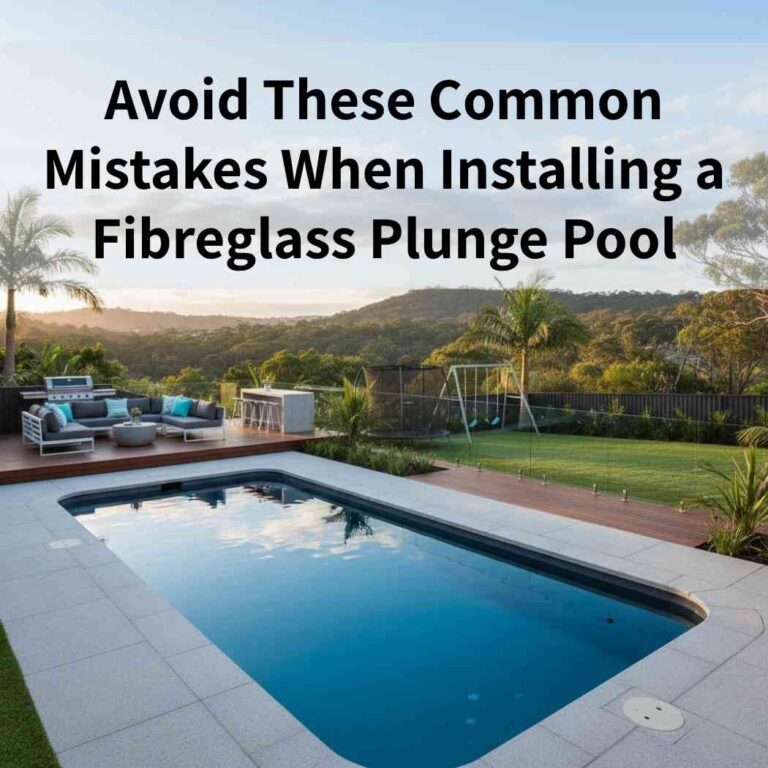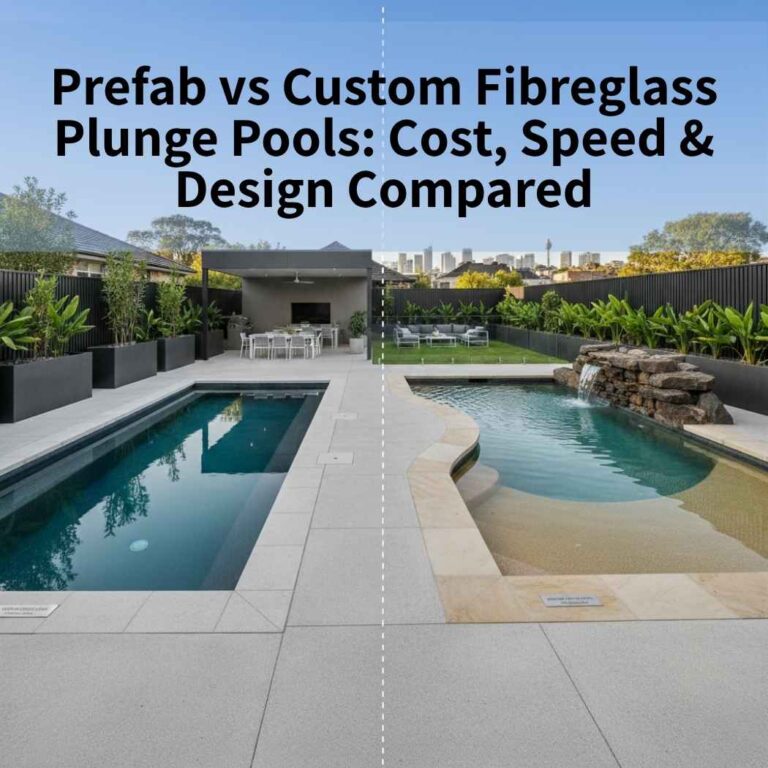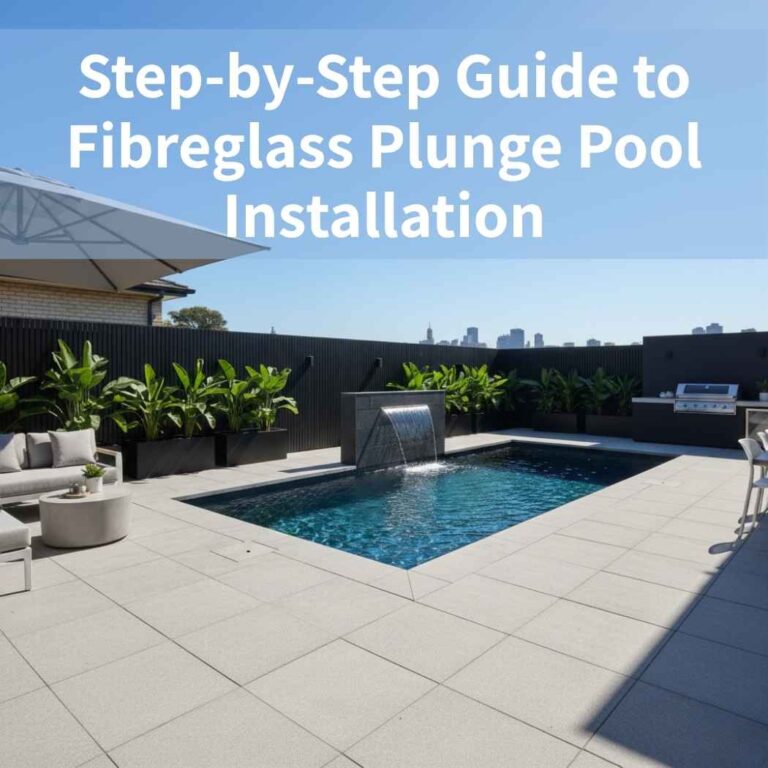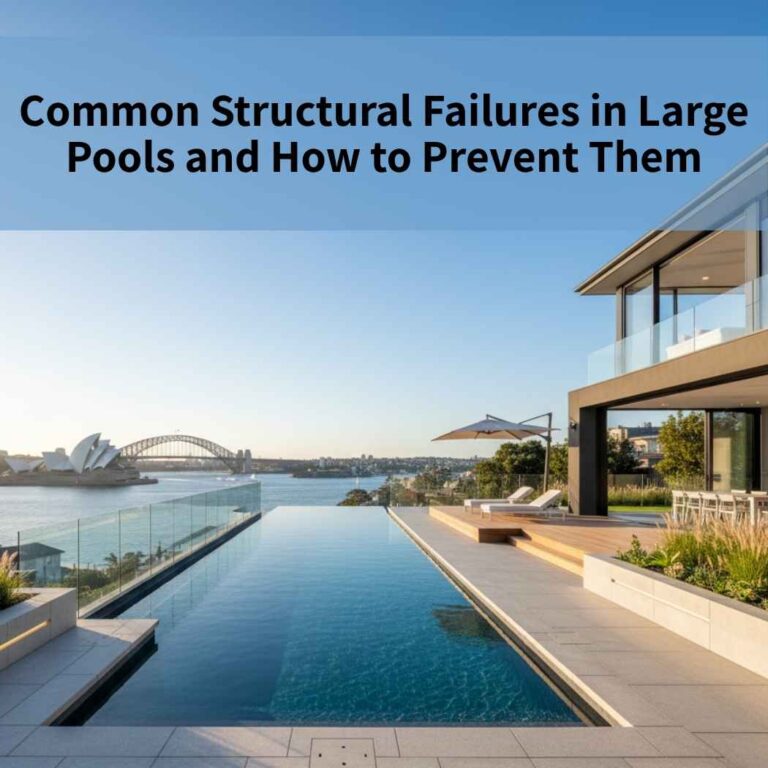At Plunge Pools Sydney, we understand local ground conditions—from coastal soils to clay-heavy backyards. Our team helps you choose the right foundation for your pool based on your site and lifestyle needs.
This guide will walk you through the pros and cons of each base option and offers expert advice tailored to Sydney conditions, so you can choose with confidence and get the most from your pool.
Table of Contents
ToggleWhy Your Above Ground Pool Needs a Proper Base
Your above-ground pool base isn’t optional. It’s not “nice to have.” It’s the foundation — literally — for whether your pool lasts years… or falls apart in months.
Here’s what happens when you cut corners on the base:
- Uneven Pool = Uneven Problems. Water leans to one side. Pool walls get stressed. Liners stretch and tear. Total disaster.
- Liner Gets Wrecked. Rocks, roots, debris — they don’t care how much you spent on your pool. They’ll shred your liner if you don’t build the right barrier.
- Water Has Nowhere to Go. Rain, splash-out, even morning dew — if your base doesn’t drain properly, water pools up and starts eating away at the structure.
- Shorter Pool Life. Cheap base = constant fixes. Constant fixes = pool lasts half as long. A solid base pays for itself in avoided headaches alone.
- Serious Safety Risks. A pool sitting on unstable ground is just waiting to shift, sag, or even collapse. That’s not a pool problem — that’s a liability problem.
Want to make sure your pool setup is done right from the start? Our team specialises in above-ground plunge pool installations across Sydney that are built to last.
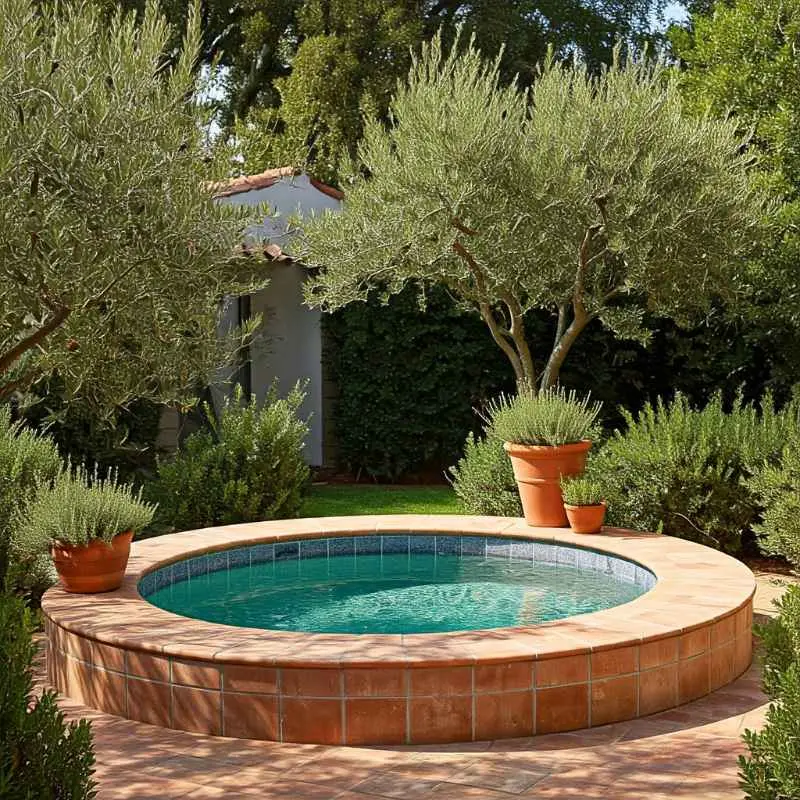
Comparison Chart: Best Bases for Above Ground Pools
Here’s the cheat sheet. No fluff. Just what each base costs, how long it lasts, how well it drains, how comfortable it is, how much of a headache installation is — and who it’s actually for.
| Base Type | Cost (per sq. ft.) | Durability | Drainage | Comfort | Ease of Installation | Best for… |
|---|---|---|---|---|---|---|
| Sand | Low | Low | Moderate | High | Easy | Budget installs |
| Gravel | Moderate | High | Excellent | Low | Moderate | Long-term installs, sloped yards |
| Concrete | High | Very High | Poor | Moderate | Difficult | Permanent installs |
| Foam Pad | Moderate | Moderate | Moderate | High | Easy | Added cushion & liner protection |
| Stone Dust | Low | Moderate | Poor | Moderate | Moderate | Low-budget installs |
| Vermiculite | Moderate | High | Excellent | High | Moderate | Flexible, shifting soil |
Want to see how your base choice affects total cost? Here’s a breakdown of what above-ground plunge pools typically cost in Sydney, including installation and extras.
Best Pool Base by Climate
1. Wet Climates
- What Works: Gravel or vermiculite.
Why: Water has to go somewhere — if your base traps it, your pool’s done. These materials drain like champions and stop water from rotting out your pool from underneath.
2. Dry Climates
- What Works: Sand or foam pads.
Why: No water to drain, so you’re playing for comfort and cost. Sand’s cheap. Foam pads keep the liner safe and add cushion. Both work.
3. Cold Climates (Frost-Prone)
- What Works: Gravel or foam pads.
Why: Frost heave destroys weak bases. Gravel flexes with the ground. Foam pads insulate your liner so it doesn’t crack when temps drop.
4. Sandy or Coastal Areas
- What Works: Concrete slab or compacted gravel (with a frame to hold it together).
Why: Sandy soil moves — constantly. If you want your pool to stay level (and not sink), you need a rock-solid base that locks in place. Concrete = no movement. Compacted gravel = drains well and holds tight.
Best Bases for Different Pool Types
1. Steel-Walled Pools
These are the heavyweights. Big. Durable. Built to last decades — if the foundation holds. Weak base? Doesn’t matter how good the pool is. It’s done.
Gravel works. Concrete works. Both hold weight, both stay put.
Want to level up? Throw a foam pad on top. Protects your liner and makes it feel better underfoot.
2. Inflatable or Soft-Sided Pools
These are light, cheap, and temporary — which means they don’t need the Fort Knox treatment. Sand works. Foam pads work. Easy, fast, no stress.
If you’re locking in a permanent spot, you can upgrade to gravel or concrete, but for most people? Not worth the overkill.
3. Oval vs Round Pools
Oval pools? More stress points. That long shape puts pressure on the sides, especially at the ends. You need something solid underneath. Concrete slab works. Gravel works.
Round pools? Way easier. Weight spreads evenly in every direction. That’s why sand or foam pads are totally fine — unless you’re trying to make it last 15+ years. In that case, gravel wins every time.
4. Sloped Yards
Sloped yard = nightmare waiting to happen. Water runs downhill, soil shifts, pool leans, walls buckle. Game over. Gravel’s your best friend here. Easy to level, drains well, stays put. If you’re serious, build a perimeter frame first.
Holds the gravel in place no matter what your yard throws at it. Concrete’s the nuclear option. Works, but you’re paying for it — and on a slope, it’s brutal to pour. Only do it if you’re going all-in on a permanent setup.
Step-by-Step Installation Guides for Popular Bases
There’s the right way. There’s the lazy way. One lasts. One costs you money. Here’s how to do it right — fast, simple, no guesswork. These are the four most popular bases — and exactly how to install each one.
Gravel Base — The Tank (Most Durable)
- 1. Mark & Measure: If your measurements suck, your pool’s screwed before you even start. Stakes, string, spray paint — whatever works. Measure twice. Mistakes cost thousands.
- 2. Excavate & Level: Dig down at least 4 inches. More if your yard slopes. Laser level or builder’s level — doesn’t matter, just make sure it’s dead flat.
- 3. Build a Perimeter Frame: Simple wood frame. Holds everything in place. No frame? Your gravel’s escaping the second water hits it.
- 4. Weed Barrier — Don’t Skip This: Roll it out. Overlap edges by at least 6 inches. Roots and weeds don’t care how much you spent on your pool — they’ll wreck it from underneath.
- 5. Add & Compact Gravel: 4 inches minimum. Crushed, clean gravel — not just any rock pile. Compact in layers. Tamp it down like your pool’s life depends on it (because it does).
- 6. Final Level Check: Straight board. Bubble level. Walk the whole thing. Fix anything now — because it’s 10 times harder after the pool’s up.
- 7. Pad & Liner: Foam pad or pool tarp on top. Then your liner. No shortcuts. No excuses.
Concrete Pad Installation
- Excavate & Frame: Dig 4-6 inches deep. Build your wooden frame to fit your pool dimensions exactly. Sloppy formwork = bad slab = problems for years.
- Reinforcement — Non-Negotiable: Rebar or wire mesh. Skipping this step guarantees cracks. Every. Single. Time.
- Pour & Screed: Outdoor-rated concrete mix. If drainage’s a concern, consider permeable concrete. Smooth it with a screed board until it’s perfectly level.
- Cure — 3 Weeks Minimum: No shortcuts here. Concrete cures on its own schedule, not yours. Keep it damp the first few days — no cracks allowed.
- Foam Pad: Once cured, drop a foam pad on top. Protects your liner, adds a little cushion. Cheap insurance for a decades-long investment.
Sand Base Installation (Budget-Friendly)
- Clear & Level: Grass, rocks, sticks — clear all of it. Rake it smooth. If the ground’s uneven now, it’ll be worse with water in the pool.
- Spread Mason Sand: 2 to 3 inches deep. Mason sand only — not beach sand, not random sandpile sand. Wrong sand = soft spots and shifting.
- Compact & Check: Tamp it down. Check for level constantly. Fixing a slope now is easy. After the pool’s up? Nightmare.
- Cement Mix Option: Want to get fancy? Mix a little dry cement into the top layer before compacting. Mist it with water. Firms up like a dream.
- Pad It: Pool pad on top. You’re not saving money skipping this — you’re just setting yourself up for liner damage.
Foam Pad Installation
- Clear & Level: Doesn’t matter if you’re laying foam on sand, gravel, or concrete — the surface underneath needs to be flat. Do it right.
- Lay Foam Sections: Piece it together. Some foam locks, some doesn’t. Just make sure there are no gaps.
- Tape It Down: Waterproof tape along every seam. If the foam shifts, your liner wrinkles. Wrinkles lead to tears. Tears lead to expensive regrets.
- Final Level Walk: Walk around. Check for dips, bumps, weird spots. Fix them now.
- Drop the Liner: Foam directly under the liner. Nothing in between. No dirt, no debris. Just soft, protective foam.
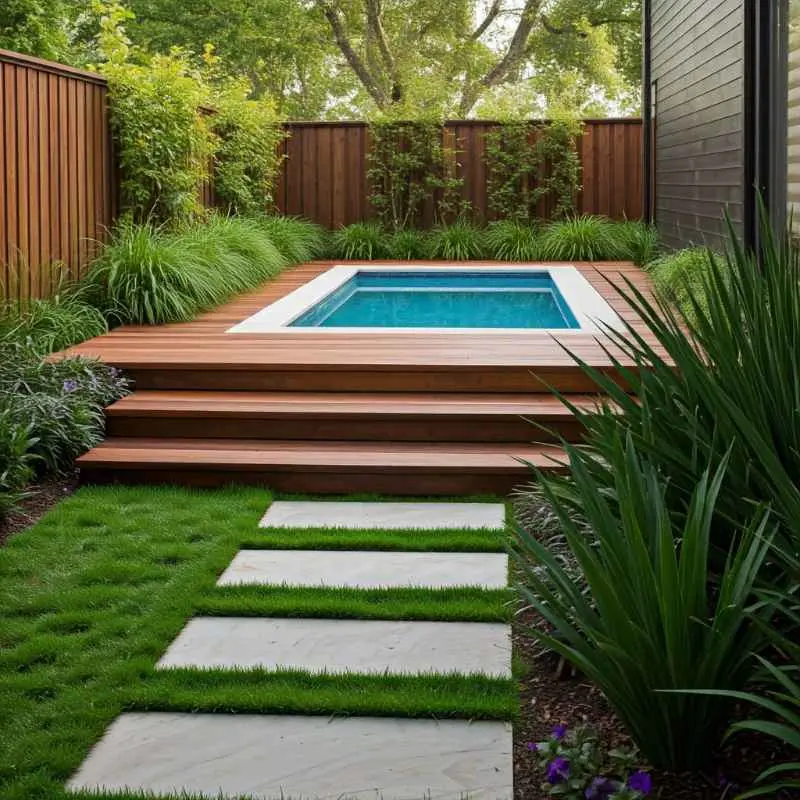
Long-Term Maintenance for Each Base
Building a solid base is step one. Keeping it solid? That’s what separates the pros from the people re-buying pools. Here’s how to make sure your base material doesn’t turn into a money pit.
- Concrete: Hairline cracks? Fill them immediately. Little cracks become big cracks — and big cracks become expensive. Want to go the extra mile? Seal the surface. Not mandatory, but it adds years to the life of your slab.
- Sand: Rain, weight, and just existing will mess with your sand. Check for low spots and footprints. Rake, refill, repeat. Weeds sneaking through? Your weed barrier shifted — fix it before roots punch through your liner.
- Foam Pads: Foam pads feel great, but they’re not invincible. See dents? Take the liner up, flatten the foam, or replace a section. Walk the edges. If the foam’s sticking out past the pool wall, you’ve got a problem — reposition it before it turns into a tear in your liner.
- Vermiculite: Vermiculite handles water well — until the yard around it changes the game. Check drainage after big rains. If water’s pooling nearby, redirect it fast. See thin spots? Mix up more vermiculite and patch it. Simple.
Eco-Friendly and Sustainable Pool Base Options
You want a pool. You don’t want to torch the environment doing it. Cool — here’s how to build a rock-solid pool foundation (base) without feeling guilty about it.
Recycled Foam Pads
Same foam pad. Same liner protection. But now it’s made from recycled materials — less landfill, more second chances for old foam. Same performance. Smaller footprint.
Permeable Concrete
Normal concrete blocks water. Permeable concrete lets water drain through, cutting runoff and helping Sydney’s stormwater systems handle the load. Same durability — smarter drainage.
Locally Sourced Gravel
Gravel works. Gravel from nearby works even better. Cuts transport emissions, supports local businesses, and still gives you that bulletproof drainage you need.
Organic Weed Barriers
Skip the synthetic weed fabric. Lay down layers of newspaper or cardboard instead. Blocks weeds, breaks down naturally, and keeps your base clean — all without plastic
Common Installation Mistakes to Avoid
Most people don’t mess up their pool because they bought the wrong pool. They mess it up because they cut corners building the base. Here’s where people blow it — don’t be them.
1. Skipping the Level Check
If your base is even a few centimetres off, your pool walls will lean, your waterline will be crooked, and your liner will stretch until it rips. Level isn’t optional — it’s the law.
2. Not Compacting the Base
Sand, gravel — doesn’t matter. If you don’t compact it, it will shift. Shifting base = shifting pool = problems you could’ve avoided with a $50 tamper.
3. Using the Wrong Sand
Not all sand is the same. Beach sand? Full of debris. Construction sand? Wrong texture. You want mason sand — clean, soft, compacts well. Anything else is a gamble.
4. Forgetting Drainage
Water’s going somewhere. If your base doesn’t direct it away, it’ll sit there, erode your foundation, and weaken your whole pool. Drainage isn’t optional — it’s survival.
5. Building a Base That’s Too Thin
4 inches for gravel or concrete. 2 to 3 inches for sand. Anything less, and your pool’s sitting on a ticking time bomb.
6. Ignoring Your Soil
Your yard matters. Got clay? Expansive soil? You can’t just slap down sand and call it a day. Sometimes you need crushed stone. Sometimes you need geotextile fabric. But you always need to know your soil.
7. Skipping the Weed Barrier
Weeds don’t care how much your pool cost. They’ll grow up, poke your liner, and destroy your investment from underneath. Lay the barrier. Protect your liner. Simple.

Conclusion
Here’s the truth—there’s no one-size-fits-all base. There’s only the best base for you. Want something rock-solid, permanent, and built to last? Go for a base like concrete — higher upfront cost, but you’ll never have to think about it again. Dealing with drainage issues or heavy rain? Gravel or vermiculite is the way to go. Both drain like a dream and flex with the ground, preventing long-term damage.
If you want your above-ground plunge pool installed right the first time — from foundation to finish — check out our installation services for above-ground plunge pools.
People Also Ask
What’s the best base for an above ground pool on grass?
None. Grass is a base for weeds, not pools. Rip it up, level the ground, then drop sand, gravel, or foam pads. Grass under a pool = disaster waiting to happen.
How do I level a yard for a pool?
Shovel. Rake. Straightedge. Level. That’s the DIY way. If your yard’s a mess or you want it dead accurate, hire pros with laser levels. Perfect level now = no problems later.
Should I use sand, gravel, or concrete under my pool?
Depends. Want cheap and easy? Sand. Want durability and drainage? Gravel. Want longevity, something you install once and never think about again? Concrete. Foam pads? That’s comfort insurance on top of any base, adding an extra layer of protection.
What’s the best pool pad for above ground pools?
High-density foam pads. Built for pools. Thick enough to protect your liner, soft enough to feel good underfoot. Bonus points if they lock together so they don’t slide.
Do I need a weed barrier under my pool?
Yes. Every. Single. Time. Weeds will punch through your liner if you don’t block them. Lay the barrier, or pay for a new liner.
Can I put my above ground pool on pavers?
Technically, yes. But pavers settle. If they aren’t 100% level, your pool won’t be either. If you do it, throw down a foam pad or sand layer on top to protect your liner.

